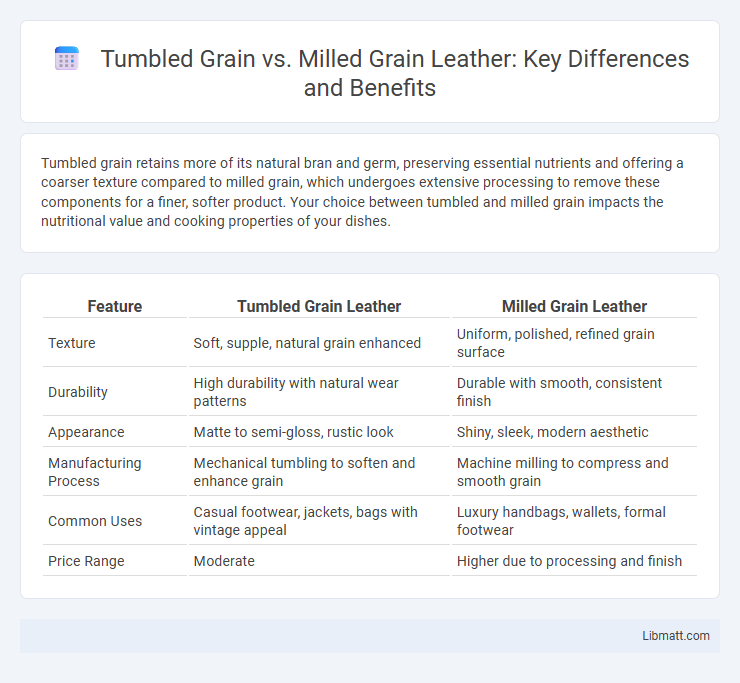Tumbled grain retains more of its natural bran and germ, preserving essential nutrients and offering a coarser texture compared to milled grain, which undergoes extensive processing to remove these components for a finer, softer product. Your choice between tumbled and milled grain impacts the nutritional value and cooking properties of your dishes.
Table of Comparison
| Feature | Tumbled Grain Leather | Milled Grain Leather |
|---|---|---|
| Texture | Soft, supple, natural grain enhanced | Uniform, polished, refined grain surface |
| Durability | High durability with natural wear patterns | Durable with smooth, consistent finish |
| Appearance | Matte to semi-gloss, rustic look | Shiny, sleek, modern aesthetic |
| Manufacturing Process | Mechanical tumbling to soften and enhance grain | Machine milling to compress and smooth grain |
| Common Uses | Casual footwear, jackets, bags with vintage appeal | Luxury handbags, wallets, formal footwear |
| Price Range | Moderate | Higher due to processing and finish |
Introduction to Grain Processing Methods
Tumbled grain and milled grain represent two distinct stages in grain processing, each affecting texture and nutrient availability. Tumbled grain is lightly crushed or abraded, preserving more of the bran and germ, which maintains higher fiber and vitamin content. Milled grain undergoes more intensive grinding, producing finer flour or meal that enhances cooking versatility but often reduces fiber and nutrient density.
Defining Tumbled Grain
Tumbled grain refers to whole grains that have undergone a gentle polishing process to remove outer bran layers while preserving the germ and endosperm, enhancing texture and cooking quality without compromising nutritional value. Unlike milled grain, which is ground into flour by removing the bran and germ entirely, tumbled grain retains more fiber, vitamins, and minerals, offering a healthier alternative for whole grain consumption. This technique maintains the grain's structural integrity, making it ideal for recipes requiring intact grain kernels with improved digestibility and flavor.
What Is Milled Grain?
Milled grain refers to grains that have been mechanically processed to remove the husk, bran, and germ, resulting in a finer texture and extended shelf life. This process produces refined grains like white rice and white flour, which lack some nutrients found in whole grains. Milled grains are often preferred in baking and cooking for their smooth consistency and quicker cooking times.
Key Differences Between Tumbled and Milled Grain
Tumbled grain retains more of its natural bran and germ due to a gentler processing method that involves polishing kernels without removing significant layers, preserving nutrients and texture. Milled grain undergoes extensive grinding and sifting to remove bran and germ, resulting in finer, softer flour with a longer shelf life but lower fiber and nutrient content. Understanding these differences helps you choose between whole grain benefits in tumbled grain or the refined texture offered by milled grain for specific baking needs.
Nutritional Impact: Tumbled vs Milled Grain
Tumbled grain retains more of its bran and germ layers, preserving higher levels of dietary fiber, vitamins, and minerals compared to milled grain, which often has these outer layers removed. This preservation results in improved nutritional profiles, such as increased B vitamins, antioxidants, and trace minerals essential for metabolic health. The milling process reduces nutrient density and elevates the glycemic index, impacting blood sugar regulation and overall dietary quality.
Flavor and Texture Differences
Tumbled grain retains more of its natural outer layers, resulting in a chewier texture and a nuttier, more complex flavor profile. Milled grain, on the other hand, has the bran and germ removed or finely ground, producing a smoother texture and a milder, more neutral taste. The choice between tumbled and milled grain significantly affects the mouthfeel and intensity of flavor in baked goods and cereals.
Benefits of Tumbled Grain
Tumbled grain retains more of its natural bran and germ layers, preserving essential nutrients like fiber, vitamins, and minerals better than milled grain. This process enhances grain texture and flavor while maintaining higher antioxidant levels that support digestive health and overall wellness. Your diet benefits from tumbled grain by providing more whole-grain nutrition, which helps regulate blood sugar and promote heart health.
Advantages of Milled Grain
Milled grain offers superior texture and flavor consistency due to the removal of bran and germ layers, which enhances baking quality and shelf life. It provides a refined, smoother flour ideal for pastries, bread, and other baked goods where fine crumb structure is essential. The milling process also boosts nutrient bioavailability, making products easier to digest compared to tumbled grain.
Applications in Baking and Cooking
Tumbled grain retains more of the bran and germ compared to milled grain, making it ideal for artisanal bread and whole grain baked goods where texture and nutritional value are prioritized. Milled grain, with its finer and more uniform particles, is preferred for cakes, pastries, and other baked goods requiring a lighter, softer crumb. Chefs often choose tumbled grain for rustic breads and hearty dishes, while milled grain suits delicate batters and refined culinary applications.
Choosing the Right Grain Processing Method
Tumbled grain preserves more of the bran and germ, retaining essential nutrients and a coarser texture ideal for hearty baked goods or whole grain products. Milled grain, often finely ground, offers a smoother texture and quicker cooking time, making it suitable for delicate pastries and refined flour recipes. Choosing the right grain processing method depends on your desired texture, nutritional goals, and recipe requirements to optimize flavor and health benefits.
Tumbled grain vs milled grain Infographic

 libmatt.com
libmatt.com